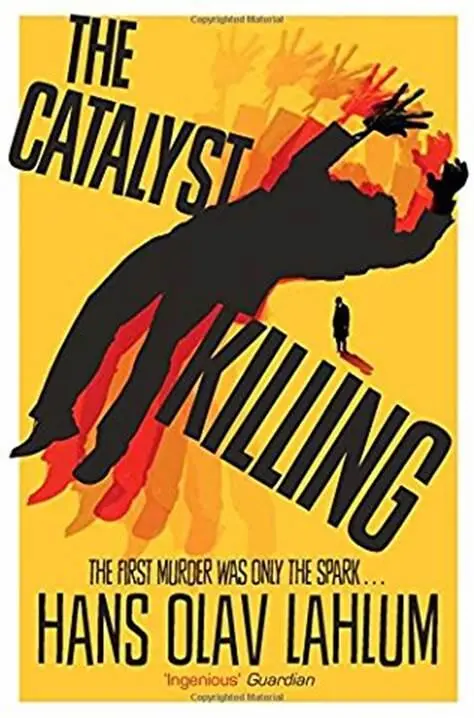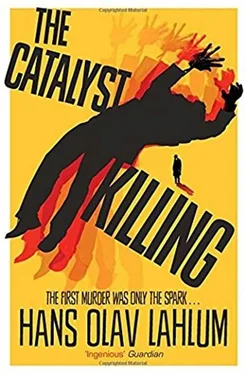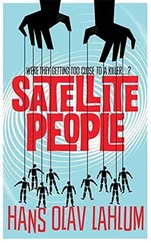
Hans Olav Lahlum
The Catalyst Killing
The third book in the DI Kolbjorn Kristiansen series, 2015
Translated from the Norwegian by Kari Dickson
To Mina -
who represents hope for the future
and a new generation of politically active
idealists…
DAY ONE: The woman on the Lijord Line
I saw her for the first time, rather suddenly and unexpectedly, at nine minutes past ten in the evening of Wednesday, 5 August 1970.
Later that evening, I would find out the young woman’s name. But over the next seven dramatic days I would continue, in my mind, to call her ‘the woman on the Lijord Line’. Had I understood the reason for her behaviour there and then, it might not only have saved her life, but also the lives of several other people.
I had finished my evening shift a few minutes earlier with a fairly routine callout to a hotel by Smestad. If the manager there had been somewhat tense before the Soviet invasion of Czechoslovakia in 1968, he had definitely become a touch paranoid since. He reported a new potential terrorist threat at the hotel roughly every other month. This time he had called about a guest whose behaviour was ‘suspiciously secretive’, one of the manager’s favourite expressions. The guest in question was a man who was possibly no more than thirty, though it was hard to say for certain because of his full beard and apparently suspiciously dark sunglasses. He was well dressed, spoke perfect Norwegian and had been politeness itself when he asked for a room with a balcony on the first floor. He had, however, not reserved a room in advance and did not give a postal address. The guest had said that he was not sure how long he would stay, but paid in cash for the first ten days at least. He did not want his room to be cleaned, and asked for a breakfast tray to be left in the hall outside his room every morning at nine o’clock. As long as the empty tray was put back out in the hall again, one could safely assume he was still there. And this had been the case for the past six days, but no member of staff had seen any other sign of life from the guest.
I dutifully put my ear to the wall in the hallway for a minute or two, without hearing anything suspicious, of course. I ascertained that there was no evidence of criminal activity, and said that there could be many explanations for the guest’s undeniably unusual behaviour. Then I promised to check the name he had given – Frank Rekkedal – in the police records, and asked them to contact us should there be any more grounds for concern.
For purely practical reasons – the axle on my police car had broken earlier in the day – I had taken a local train to Smestad. So, at nine minutes past ten, I boarded the train back into the city centre. It was a very quiet summer’s evening in Smestad. I had been the only passenger waiting on the platform.
It was just as I sat down that I saw her for the first time. She emerged very suddenly from the darkness on the road leading up the platform. And she was moving fast, extremely fast.
My first thought was that she must be a top athlete, as I could not remember having seen a woman run so fast before. Then I imagined that I might soon see a man with an axe or a scythe running after her. But there was no sign of any pursuer, even though I could see a good twenty to thirty yards behind her. In fact, there was no one else to be seen out there. And yet the woman ran even faster, despite her extremely tight jeans, hurtling towards the last door of the last carriage. It dawned on me that she might in fact be a madwoman as, despite her speed, she was running in a very odd way. Twice she hopped to the left at full speed, and once to the right.
Despite her tremendous exertion, she did not manage to reach the train in time. The doors slid shut right in front of her. It felt as though the entire carriage shuddered when she ran into them. For a couple of seconds, we stared at each other through the glass windows in the doors. I could see that she had long blonde hair and guessed that she was in her mid-twenties and slightly taller than average. It was, however, her face that struck me. It was a frozen mask of fear. The blue eyes that stared into mine were as wide as could be.
The doors did nothing to stop the young woman’s desperation. She hammered on them with her fists in despair and then pointed a trembling finger at me, or at something behind me.
I turned around automatically but could see no one else in the carriage. It was only once the train had left Smestad station that I realized she had been pointing at the emergency cord on the wall.
I sat and thought about this strange encounter with the woman on the Lijord Line all the way back into town. The trains were still running every twenty minutes, so it could surely not have been such a disaster that she missed it. By the time I got off at Nationaltheatret, I had dismissed the whole incident, having convinced myself that she was obviously a few sandwiches short of a picnic. I did not regret that I had lacked the sense to use the emergency brake, and thought to myself it was just as well as I would probably never see her again.
But I did see her again – that very same evening, in the very same place. At five to eleven, to be precise, only moments after I had jumped out of a police car borrowed from Smestad police station.
In my somewhat feeble defence, I did immediately realize what had happened when I got a telephone call from Holmenkollen at a quarter to eleven to say that the train that left Smestad station at twenty-nine minutes past ten had run over a young woman on the tracks.
When I returned, the woman on the Lijord Line lay immobile and lifeless on the tracks, in sharp contrast to the energy and sheer speed she had displayed in her mad dash to catch the train when I left Smestad only an hour ago. It was without a doubt the same woman. I recognized her jeans and her fair hair.
The driver was understandably beside himself. He repeated over and over that the woman had been lying on the tracks when he ran over her, and it had been impossible to see her in the pitch black until the train was almost on top of her, and by then it was technically impossible to stop. It had all happened so fast and been so terrible that he could not say whether she had been alive or not before he hit her. Fortunately, he seemed to calm down a bit when I assured him for the fourth time that no one suspected him of negligence or any other criminal act.
According to the student ID card she had in her purse along with three ten-kroner notes, a fifty-kroner note, a monthly travel pass and two keys, the woman on the Lijord Line was called Marie Morgenstierne. She studied politics at the University of Oslo and had apparently celebrated her twenty-fifth birthday four weeks earlier. That was all we found that might be of any interest. If she had had a bag with her that evening, it had been lost before her dramatic flight ended on the tracks.
It struck me immediately that I had heard the name Marie Morgenstierne before. But there and then, I could not recall where or under what circumstances.
The train had been coming to a halt when it hit her, but her upper body was so badly injured on impact that it was impossible to establish the cause of death at the scene. Her face, however, was intact. She stared up at me with the same frozen expression of fear that I had seen through the train window scarcely an hour earlier.
Again I wondered whether she might simply be a disturbed woman who had thrown herself in front of the train, or whether there was something else behind this. And then I promised myself that I would not let this case go until I found out. Fortunately I had no idea how many days this would take, or how complex the search for the truth about the death of the woman on the Lijord Line would prove to be.
Читать дальше













